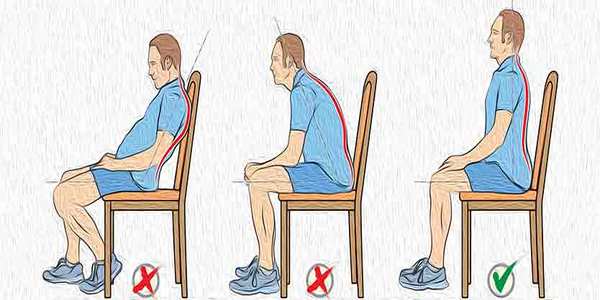Posture is the way in which you hold your body while sitting, standing or sleeping. Good posture is key to performing
[the_ad id=”6114″]daily activities with little stress and with more energy. It is important to maintain the right pose because:
- It is said to facilitate right breathing
- It lowers the level of stress on the spinal column
- It helps to maintain your energy levels
- It prevents muscle aches and fatigue.
What is a bad posture?
Day-to-day habits such as slouching, sitting slumped with a rounded lower back, cradling the phone in one ear, sitting cross-legged, hunching forward, etc. are referred to as wrong or incorrect postures. These cause tension and straining of the muscles and soft tissues in the spine, back muscles, hips, shoulders, neck, and the abdominal wall.
What are the symptoms?
Symptoms can include rounded shoulders, head either leaning forward or backwards, potbelly, bent knees while standing or walking, headache, back pain, body aches and fatigue.
What are the complications of a bad posture?
Some of the complications caused due to poor posture include:
- Back pain
- Sciatica
- Digestive problems
- Carpal tunnel syndrome
What are the ways to improve posture?
Here are a few ways to improve your posture at your office and home:
Day-to-day activities:
While sleeping
- Sleep on a firm mattress on your side with your knees bent, and use a pillow that will support your neck and spine to maintain the same shape when you are upright.
- Sleep on your back by keeping a small pillow that supports your neck.
- Avoid using thick pillows or sleeping on your stomach.
While sitting
- Use a chair which supports your lower back firmly.
- Ensure that your desk or tabletop is elbow high.
- The chair should be placed in line with the table.
- Use a small pillow or cushion to support your back.
- Use a footrest to reduce pressure on the back of your legs.
- Keep your knees a little higher than your hips.
- Get up or stretch your hands and legs as frequently as possible. You can take a small break and walk once every hour if your work involves sitting for an extended period.
- If you spend a lot of time on calls, use a headset instead of resting the phone on your shoulder.
- Do not sit on a hefty wallet; it can cause hip imbalance!
- Avoid slouching forward in case you are a computer user.
- Do not sit on the low-seated couch for a long time.
While standing
- Hold your head high, chin firmly forward, shoulders back, chest out, and stomach tucked in to increase your balance.
- If you are involved in the job where you may have to stand the entire day like teaching, security job, cooking, etc. rest one foot on a stool or take regular breaks (once every half or one hour) and walk around for a while.
- Ensure your feet lie flat on the ground so that the entire weight of the body is equally distributed on both the feet.
- Do not stand for long hours if you are wearing high heels and leaning on one side.
Beware of activities that can injure your back:
Carrying weight
- In case you are carrying heavy bags, distribute the weight of your luggage evenly on either side of your body.
- It is safe to use a backpack so that the weight is distributed evenly over the shoulders.
Bending
- In case you want to lift or reach something lying on the floor, keep your back straight and bend your knees.
- Avoid twisting and bending forward at the same time.
Helpful Tips
Reduce stress
- Stress and emotions like anger or fear can increase stiffness in the body and depression can make you slouch.
- Try stress reducing methods like music, dancing, etc.
- Go for yoga. The yoga poses not only help in reducing the stiffness of the muscles but also help in calming the mind.
Eat nutritious food
- Your body requires nutritious food like dairy foods, fatty fish, olives, etc. to keep your bones and muscles fit.
Exercise regularly
- Devote at least 10 minutes daily for doing simple stretching exercises.
- Lie down flat on the ground for few minutes every day without using any cushions or support. This pose helps your body to readapt to its natural resting position.
Source:
